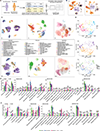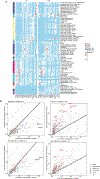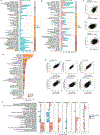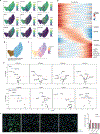The landscape of immune dysregulation in Crohn's disease revealed through single-cell transcriptomic profiling in the ileum and colon
- PMID: 36720220
- PMCID: PMC9957882
- DOI: 10.1016/j.immuni.2023.01.002
The landscape of immune dysregulation in Crohn's disease revealed through single-cell transcriptomic profiling in the ileum and colon
Erratum in
-
The landscape of immune dysregulation in Crohn's disease revealed through single-cell transcriptomic profiling in the ileum and colon.Immunity. 2023 Dec 12;56(12):2855. doi: 10.1016/j.immuni.2023.10.017. Immunity. 2023. PMID: 38091954 No abstract available.
Abstract
Crohn's disease (CD) is a chronic gastrointestinal disease that is increasing in prevalence worldwide. CD is multifactorial, involving the complex interplay of genetic, immune, and environmental factors, necessitating a system-level understanding of its etiology. To characterize cell-type-specific transcriptional heterogeneity in active CD, we profiled 720,633 cells from the terminal ileum and colon of 71 donors with varying inflammation status. Our integrated datasets revealed organ- and compartment-specific responses to acute and chronic inflammation; most immune changes were in cell composition, whereas transcriptional changes dominated among epithelial and stromal cells. These changes correlated with endoscopic inflammation, but small and large intestines exhibited distinct responses, which were particularly apparent when focusing on IBD risk genes. Finally, we mapped markers of disease-associated myofibroblast activation and identified CHMP1A, TBX3, and RNF168 as regulators of fibrotic complications. Altogether, our results provide a roadmap for understanding cell-type- and organ-specific differences in CD and potential directions for therapeutic development.
Keywords: Crohn's disease; IBD; high-dimensional profiling; inflammation; inflammatory bowel disease; myofibroblasts; single-cell RNA sequencing.
Copyright © 2023 Elsevier Inc. All rights reserved.
Conflict of interest statement
Declaration of interests R.J.X. is a co-founder of Celsius Therapeutics and Jnana Therapeutics.
Figures





References
-
- Molodecky NA, Soon IS, Rabi DM, Ghali WA, Ferris M, Chernoff G, Benchimol EI, Panaccione R, Ghosh S, Barkema HW, et al. (2012). Increasing incidence and prevalence of the inflammatory bowel diseases with time, based on systematic review. Gastroenterology 142, 46–54.e42; quiz e30. - PubMed
-
- Ng SC, Shi HY, Hamidi N, Underwood FE, Tang W, Benchimol EI, Panaccione R, Ghosh S, Wu JCY, Chan FKL, et al. (2017). Worldwide incidence and prevalence of inflammatory bowel disease in the 21st century: a systematic review of population-based studies. Lancet 390, 2769–2778. - PubMed
Publication types
MeSH terms
Substances
Grants and funding
LinkOut - more resources
Full Text Sources
Other Literature Sources
Medical
Research Materials

